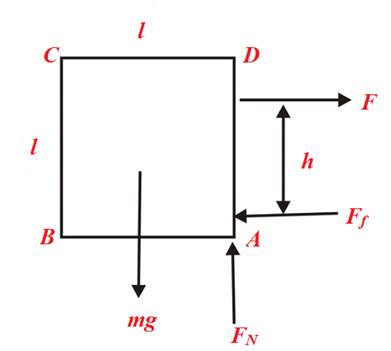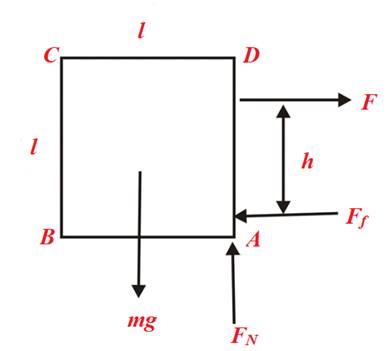
Concept explainers
(a)
To find: The coefficient of static friction
(a)
Answer to Problem 69GP
Explanation of Solution
Given:
The side of the cube is,
The magnitude of the horizontal force is,
The height from the floor the force is acting is,
The coefficient of static friction is,
Formula used:
Consider the block diagram shown below.

From the equilibrium condition in x -direction:
Consider the torque counter-clockwise as positive. The net torque at point A is zero.
Calculation:
From equation (1) and (2),
Substitute the value of
For the block began to slide rather than a tip.
Conclusion:
The value of static friction should be less than
(b)
To find: The coefficient of static friction
(b)
Answer to Problem 69GP
Explanation of Solution
Given:
The side of the cube is,
The magnitude of the horizontal force is,
The height from the floor the force is acting is,
The coefficient of static friction is,
Formula used:
Consider the block diagram shown below.

From the equilibrium condition in x -direction:
Consider the torque counter-clockwise as positive. The net torque at point A is zero.
Calculation:
From equation (1) and (2).
Substitute the value of
For the block began to tip,
Conclusion:
The value of static friction should be more than
Chapter 9 Solutions
Physics: Principles with Applications
Additional Science Textbook Solutions
Campbell Essential Biology (7th Edition)
Microbiology: An Introduction
Anatomy & Physiology (6th Edition)
Campbell Biology (11th Edition)
Applications and Investigations in Earth Science (9th Edition)
Human Biology: Concepts and Current Issues (8th Edition)
- 3arrow_forwardSet ба ||Axl 49.32 6b 71 Ay 22 Magnitude of A Angle of A 24.04 Angle of -A 22 54 155.96 ° (pos Ax) 204.04 ° (neg Ax) 335.96 ° (pos Ax) ° (neg Ax) 115.77 ° (pos Ax) 295.77 ° (pos Ax) -39 81 208.78 ° (neg Ax) 28.78 ° (neg Ax)arrow_forward3AA . not sure what i am getting wrongarrow_forward
 College PhysicsPhysicsISBN:9781305952300Author:Raymond A. Serway, Chris VuillePublisher:Cengage Learning
College PhysicsPhysicsISBN:9781305952300Author:Raymond A. Serway, Chris VuillePublisher:Cengage Learning University Physics (14th Edition)PhysicsISBN:9780133969290Author:Hugh D. Young, Roger A. FreedmanPublisher:PEARSON
University Physics (14th Edition)PhysicsISBN:9780133969290Author:Hugh D. Young, Roger A. FreedmanPublisher:PEARSON Introduction To Quantum MechanicsPhysicsISBN:9781107189638Author:Griffiths, David J., Schroeter, Darrell F.Publisher:Cambridge University Press
Introduction To Quantum MechanicsPhysicsISBN:9781107189638Author:Griffiths, David J., Schroeter, Darrell F.Publisher:Cambridge University Press Physics for Scientists and EngineersPhysicsISBN:9781337553278Author:Raymond A. Serway, John W. JewettPublisher:Cengage Learning
Physics for Scientists and EngineersPhysicsISBN:9781337553278Author:Raymond A. Serway, John W. JewettPublisher:Cengage Learning Lecture- Tutorials for Introductory AstronomyPhysicsISBN:9780321820464Author:Edward E. Prather, Tim P. Slater, Jeff P. Adams, Gina BrissendenPublisher:Addison-Wesley
Lecture- Tutorials for Introductory AstronomyPhysicsISBN:9780321820464Author:Edward E. Prather, Tim P. Slater, Jeff P. Adams, Gina BrissendenPublisher:Addison-Wesley College Physics: A Strategic Approach (4th Editio...PhysicsISBN:9780134609034Author:Randall D. Knight (Professor Emeritus), Brian Jones, Stuart FieldPublisher:PEARSON
College Physics: A Strategic Approach (4th Editio...PhysicsISBN:9780134609034Author:Randall D. Knight (Professor Emeritus), Brian Jones, Stuart FieldPublisher:PEARSON





